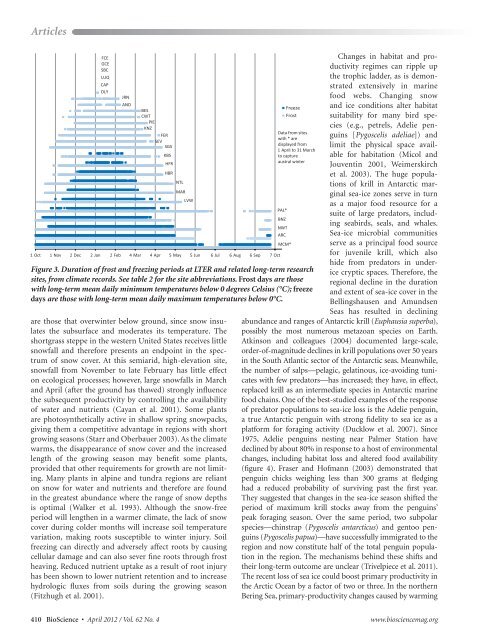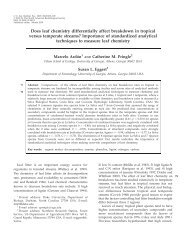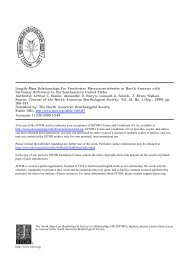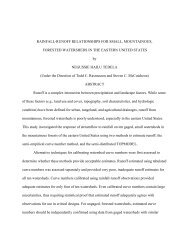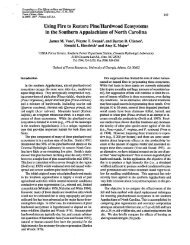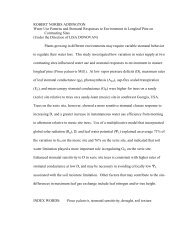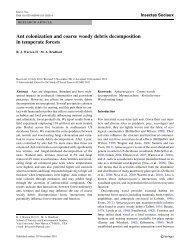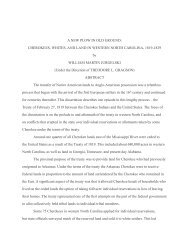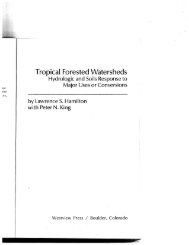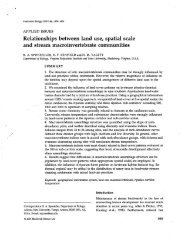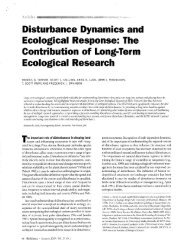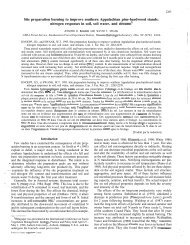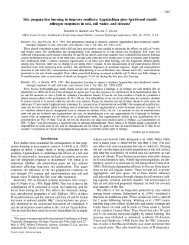biology join - Coweeta LTER - University of Georgia
biology join - Coweeta LTER - University of Georgia
biology join - Coweeta LTER - University of Georgia
Create successful ePaper yourself
Turn your PDF publications into a flip-book with our unique Google optimized e-Paper software.
Articles<br />
Figure 3. Duration <strong>of</strong> frost and freezing periods at <strong>LTER</strong> and related long-term research<br />
sites, from climate records. See table 2 for the site abbreviations. Frost days are those<br />
with long-term mean daily minimum temperatures below 0 degrees Celsius (°C); freeze<br />
days are those with long-term mean daily maximum temperatures below 0°C.<br />
are those that overwinter below ground, since snow insulates<br />
the subsurface and moderates its temperature. The<br />
shortgrass steppe in the western United States receives little<br />
snowfall and therefore presents an endpoint in the spectrum<br />
<strong>of</strong> snow cover. At this semiarid, high-elevation site,<br />
snowfall from November to late February has little effect<br />
on ecological processes; however, large snowfalls in March<br />
and April (after the ground has thawed) strongly influence<br />
the subsequent productivity by controlling the availability<br />
<strong>of</strong> water and nutrients (Cayan et al. 2001). Some plants<br />
are photosynthetically active in shallow spring snowpacks,<br />
giving them a competitive advantage in regions with short<br />
growing seasons (Starr and Oberbauer 2003). As the climate<br />
warms, the disappearance <strong>of</strong> snow cover and the increased<br />
length <strong>of</strong> the growing season may benefit some plants,<br />
provided that other requirements for growth are not limiting.<br />
Many plants in alpine and tundra regions are reliant<br />
on snow for water and nutrients and therefore are found<br />
in the greatest abundance where the range <strong>of</strong> snow depths<br />
is optimal (Walker et al. 1993). Although the snow-free<br />
period will lengthen in a warmer climate, the lack <strong>of</strong> snow<br />
cover during colder months will increase soil temperature<br />
variation, making roots susceptible to winter injury. Soil<br />
freezing can directly and adversely affect roots by causing<br />
cellular damage and can also sever fine roots through frost<br />
heaving. Reduced nutrient uptake as a result <strong>of</strong> root injury<br />
has been shown to lower nutrient retention and to increase<br />
hydrologic fluxes from soils during the growing season<br />
(Fitzhugh et al. 2001).<br />
Changes in habitat and productivity<br />
regimes can ripple up<br />
the trophic ladder, as is demonstrated<br />
extensively in marine<br />
food webs. Changing snow<br />
and ice conditions alter habitat<br />
suitability for many bird species<br />
(e.g., petrels, Adelie penguins<br />
[Pygoscelis adeliae]) and<br />
limit the physical space available<br />
for habitation (Micol and<br />
Jouventin 2001, Weimerskirch<br />
et al. 2003). The huge populations<br />
<strong>of</strong> krill in Antarctic marginal<br />
sea-ice zones serve in turn<br />
as a major food resource for a<br />
suite <strong>of</strong> large predators, including<br />
seabirds, seals, and whales.<br />
Sea-ice microbial communities<br />
serve as a principal food source<br />
for juvenile krill, which also<br />
hide from predators in underice<br />
cryptic spaces. Therefore, the<br />
regional decline in the duration<br />
and extent <strong>of</strong> sea-ice cover in the<br />
Bellingshausen and Amundsen<br />
Seas has resulted in declining<br />
abundance and ranges <strong>of</strong> Antarctic krill (Euphausia superba),<br />
possibly the most numerous metazoan species on Earth.<br />
Atkinson and colleagues (2004) documented large-scale,<br />
order-<strong>of</strong>- magnitude declines in krill populations over 50 years<br />
in the South Atlantic sector <strong>of</strong> the Antarctic seas. Meanwhile,<br />
the number <strong>of</strong> salps—pelagic, gelatinous, ice-avoiding tunicates<br />
with few predators—has increased; they have, in effect,<br />
replaced krill as an intermediate species in Antarctic marine<br />
food chains. One <strong>of</strong> the best-studied examples <strong>of</strong> the response<br />
<strong>of</strong> predator populations to sea-ice loss is the Adelie penguin,<br />
a true Antarctic penguin with strong fidelity to sea ice as a<br />
platform for foraging activity (Ducklow et al. 2007). Since<br />
1975, Adelie penguins nesting near Palmer Station have<br />
declined by about 80% in response to a host <strong>of</strong> environmental<br />
changes, including habitat loss and altered food availability<br />
(figure 4). Fraser and H<strong>of</strong>mann (2003) demonstrated that<br />
penguin chicks weighing less than 300 grams at fledging<br />
had a reduced probability <strong>of</strong> surviving past the first year.<br />
They suggested that changes in the sea-ice season shifted the<br />
period <strong>of</strong> maximum krill stocks away from the penguins’<br />
peak foraging season. Over the same period, two subpolar<br />
species—chinstrap (Pygoscelis antarcticus) and gentoo penguins<br />
(Pygoscelis papua)—have successfully immigrated to the<br />
region and now constitute half <strong>of</strong> the total penguin population<br />
in the region. The mechanisms behind these shifts and<br />
their long-term outcome are unclear (Trivelpiece et al. 2011).<br />
The recent loss <strong>of</strong> sea ice could boost primary productivity in<br />
the Arctic Ocean by a factor <strong>of</strong> two or three. In the northern<br />
Bering Sea, primary-productivity changes caused by warming<br />
410 BioScience • April 2012 / Vol. 62 No. 4 www.biosciencemag.org


